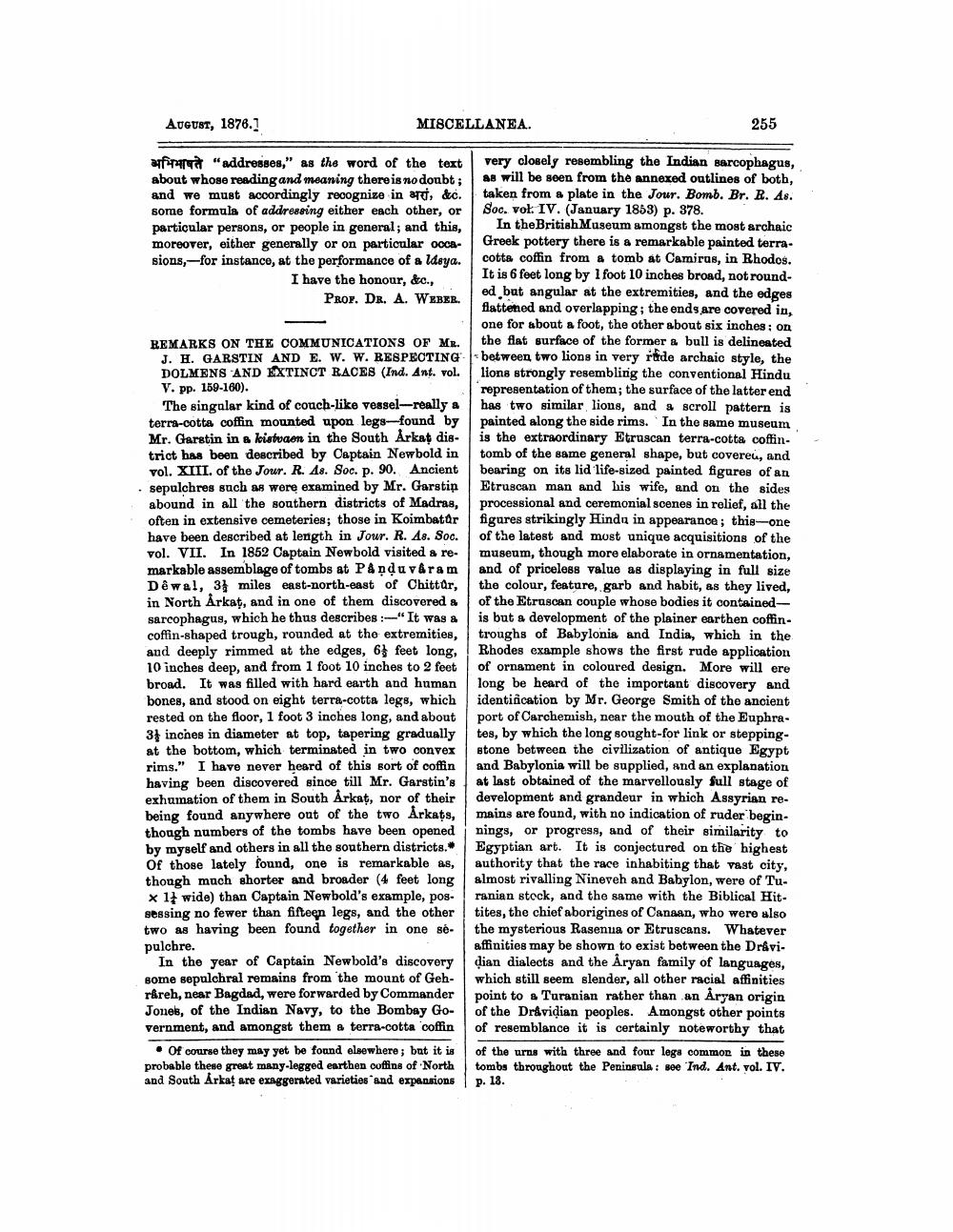________________
AUGUST, 1876.]
MISCELLANEA.
255
afinerea "addresses," as the word of the text very closely resembling the Indian sarcophagus, about whose reading and meaning there is no doubt;
as will be seen from the annexed outlines of both, and we must accordingly recognize in aru, &c. taken from & plate in the Jour. Bomb. Br. R. As. some formula of addressing either each other, or Soc. vol. IV. (January 1853) p. 378. particular persons, or people in general; and this,
In the British Museum amongst the most archaic moreover, either generally or on particular occa- Greek pottery there is a remarkable painted terra. sions,-for instance, at the performance of a ldeya.
cotta coffin from a tomb at Camirus, in Rhodos. I have the honour, &c.,
It is 6 foet long by 1 foot 10 inches broad, not roundPROF. DR. A. WEBER.
ed but angular at the extremities, and the edges flattened and overlapping; the ends are covered in,
one for about a foot, the other about six inches : on REMARKS ON THE COMMUNICATIONS OF MR. the flat surface of the former & bull is delineated
J. H. GARSTIN AND E. W. W. RESPECTING between two lions in very rttde archaic style, the DOLMENS AND EXTINCT RACES (Ind. Ant. vol. lions strongly resembling the conventional Hindu V. pp. 159-160).
representation of them; the surface of the latter end The singular kind of couch-like vessel-really a has two similar lions, and a scroll pattern is terra-cotta coffin mounted upon legs-found by painted along the side rims. In the same museum Mr. Garstin in a kistvaon in the South Arkat dis- is the extraordinary Etruscan terra-cotta coffintrict has been described by Captain Newbold in tomb of the same general shape, but covered, and vol. XIII. of the Jour. R. As. Soc. p. 90. Ancient bearing on its lid life-sized painted figures of an sepulchres such as were examined by Mr. Garstin Etruscan man and his wife, and on the sides abound in all the southern districts of Madras, processional and ceremonial scenes in relief, all the often in extensive cemeteries; those in Koimbator figures strikingly Hinda in appearance; this--one have been described at length in Jour. R. 48. Soc. of the latest and most unique acquisitions of the vol. VII. In 1852 Captain Newbold visited a re- museum, though more elaborate in ornamentation, markable assemblage of tombs at På du v&ram and of priceless value as displaying in full size Dewal, 3} miles east-north-east of Chittar, the colour, feature, garb and habit, as they lived, in North Årkat, and in one of them discovered & of the Etruscan couple whose bodies it containedsarcophagus, which he thus describes :-" It was a is but a development of the plainer earthen coffincoffin-shaped trough, rounded at the extremities, troughs of Babylonia and India, which in the and deeply rimmed at the edges, 6 feet long, Rhodes example shows the first rude application 10 inches deep, and from 1 foot 10 inches to 2 feet of ornament in coloured design. More will ere broad. It was filled with hard earth and human long be heard of the important discovery and bones, and stood on eight terra-cotta legs, which identification by Mr. George Smith of the ancient rested on the floor, 1 foot 3 inches long, and about port of Carchemish, near the mouth of the Euphra3 inches in diameter at top, tapering gradually tes, by which the long sought-for link or steppingat the bottom, which terminated in two convex stone between the civilization of antique Egypt rims." I have never heard of this sort of coffin and Babylonia will be supplied, and an explanation having been discovered since till Mr. Garstin's at last obtained of the marvellously full stage of exhumation of them in South Årkat, nor of their development and grandeur in which Assyrian rebeing found anywhere out of the two Arkats, mains are found, with no indication of ruder beginthough numbers of the tombs have been openednings, or progress, and of their similarity to by myself and others in all the southern districts. Egyptian art. It is conjectured on the highest Of those lately found, one is remarkable as, authority that the race inhabiting that vast city, though much shorter and broader (4 feet long almost rivalling Nineveh and Babylon, were of Tux 17 wide) than Captain Newbold's example, pos- ranian stock, and the same with the Biblical Hitsessing no fewer than fifteen legs, and the other tites, the chief aborigines of Canaan, who were also two as having been found together in one sé. the mysterious Rasenua or Etruscans. Whatever pulchre.
affinities may be shown to exist between the Dravi. In the year of Captain Newbold's discovery dian dialects and the Aryan family of languages, some sepulchral remains from the mount of Geh- which still seem slender, all other racial affinities râreh, near Bagdad, were forwarded by Commander point to a Turanian rather than an Aryan origin Jones, of the Indian Navy, to the Bombay Go- of the Dravidian peoples. Amongst other points vernment, and amongst them & terra-cotta coffin of resemblance it is certainly noteworthy that
• Of course they may yet be found elsewhere; but it is of the urns with three and four legs common in these probable these great many legged earthen coffins of North tombs throughout the Peninsula: soe 'Ind. Ant. vol. IV. and South Arkat are exaggerated varieties and expansions 1 p. 18.




